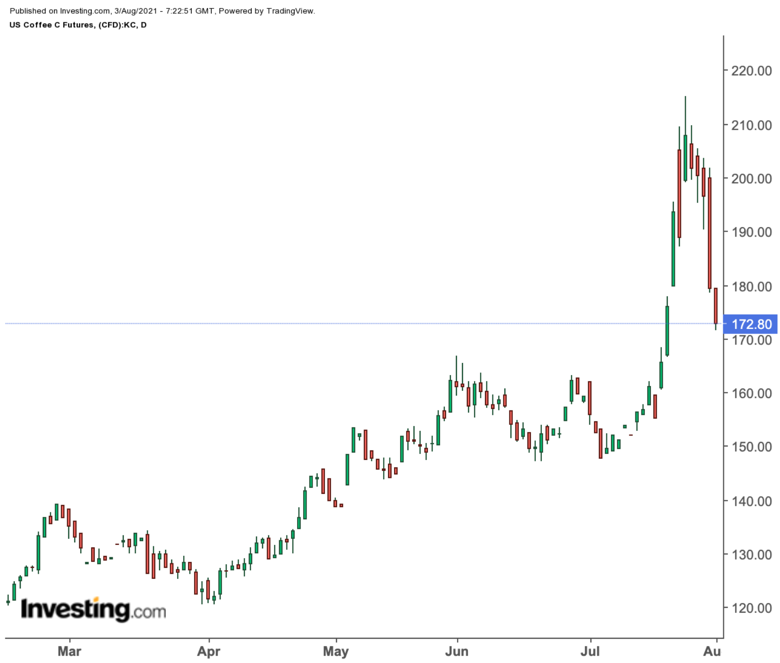Abracadabra: The rally in arabica is gone!
Prices of coffee’s premium beans have fallen non-stop over the past five sessions after gaining 30% over the two previous weeks.
Technically speaking, arabica coffee is already in a bear market, having slipped the prerequisite 20% from its near seven-year high of $2.152 per lb on July 26 to $1.716 by Monday’s close on ICE Futures US.
Yet, it doesn’t feel right to call it a bear market, given that it is still holding some 14% of its original rally between the weeks of July 4 and 18.
The bull run in arabica unraveled for the same reason that drove it up: fear of a crop freeze.
While in mid-July, the concern was that the south of Minas Gerais, Brazil’s top coffee producing region, was getting hit by a severe chill that could damage the upcoming harvest, in recent days the worry was that the cold had been overplayed and the market overbought.
Jack Scoville, chief crop analyst at Chicago broker Price Futures Group, laid it out in a post on Monday:
“The freeze threat in Brazil passed with some damage. Temperatures are now expected to trend a little warmer. The market had traded sharply higher early this week on freezing temperatures in Brazil growing areas early last week and forecasts for more late last week.”
Scoville said it might still be too early to write off the frost damage altogether, meaning the market could rebound in the coming days. “It is not yet known how extensive the damage was but ideas are that a significant part of the crop got hurt,” he said, adding that the Minasul coffee cooperative in Brazil has estimated a quarter of the crop may be at stake.
“It is flowering-time for the next crop and frozen flowers will drop off the trees.”
Scoville’s comments concurred with that of Drew Lerner, president of World Weather, who was quoted saying on Bloomberg that frost overnight reached about 80% of south Minas Gerais but the impact was less than feared. The area may get “patchy frost” Saturday and Sunday. Most sugar and citrus areas were spared the worst readings, and any impact was probably localized, Lerner said.
Carlos Mera, head of agricultural research at Rabobank International, said on the same Bloomberg report:
“Any losses from today’s event will be very limited. However, we still see some potential for frosts in the coming three days.”
Even with Friday’s drop, consumers could still see higher coffee prices at cafes and supermarkets when global food prices in general are on the rise, Bloomberg added.
But what does the collapse mean for investors in ICE Futures of arabica?
Do Buyers Pull The Trigger or Wait Further?
As we said in a July 27 report, technical charts tracked by Investing.com indicate a correction first before arabica ran further upward, suggesting a buy-on-the-dip opportunity for those willing to wait.
Well that dip has certainly come; so do potential buyers pull the trigger now or wait further?
As technical chartist Sunil Kumar Dixit projected in our July 27 outlook, the near 7-year high of $2.152 for arabica had a better chance of traveling down to the five-year Exponential Moving Average of $1.89 and the static horizontal support of $1.69.
“On an immediate basis, coffee is more likely to undergo a natural price correction before hitting through $2.25, the level reached in 2014,” said Dixit of SK Dixit Charting in Kolkata, India.
At Tuesday’s preopen, arabica was at $1.7295 per lb—still a little way from the $1.89-$1.69 downside target eyed by Dixit.
But Dixit’s charts also indicate another breakout to the higher side, should concerns about extensive damage to the Brazilian crop resurface causing global tightness in coffee supply.
Brazil, after all, accounts for 40% of world coffee output, and is the main source of arabica beans for renowned chains such as Starbucks (NASDAQ:SBUX) and Tim Hortons.
“On the upper channel, coffee can certainly extend to the record high of $3.06 reached in May 2011,” Dixit said in his outlook.
Disclaimer: Barani Krishnan uses a range of views outside his own to bring diversity to his analysis of any market. For neutrality, he sometimes presents contrarian views and market variables. He does not hold a position in the commodities and securities he writes about.
